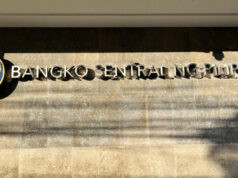Philippine financial system grows in 2018 as lenders’ assets expand
THE PHILIPPINE financial system sustained its growth in the second half of 2018 on the back of the banking industry’s expansion, ending the year with an uptrend in assets, loans, deposits, and capital, according to the Bangko Sentral ng Pilipinas (BSP).
“With the banking system at its core, the Philippine financial system has exhibited resilience amid evolving domestic and global environment. It continued to expand its assets, particularly its lending and investment portfolios, to support private and public financing needs and in turn promote economic growth. Its activities brought higher profitability, while maintaining adequate capitalization and liquidity buffers to absorb potential shocks to operations,” the BSP said in its Report on the Philippine Financial System for the second semester released over the weekend.
The report said the financial system’s resources expanded by 9.3% year-on-year in 2018. The growth of the financial system was driven by the growth of the banking system’s assets by 11.5% year-on-year to P16.9 trillion. Meanwhile, non-bank financial institutions’ assets increased by 7.6%, mainly driven by the expansion in the loan portfolio of financing companies and non-stock savings and loans associations.
The financial system is composed of the banking industry as well as non-bank financial institutions. Banks accounted for 83% of the total resources of the Philippine financial system as of end-December 2018, the report said.
The growth of the banking system’s assets was primarily driven by the expansion of the resources of universal and commercial banks, which held bulk of the industry’s assets at P15.42 trillion, up 12% year-on-year, the BSP said. Thrift banks and rural and cooperative lenders meanwhile logged slower asset growth at 6.5% (to P1.25 trillion) and 7.2% (to P245.6 billion), respectively.
“The Philippine banking system sustained its growth story capping the year 2018 with notable uptrends in assets, loans, deposits and capital. The banking system maintained its solid footing as evidenced by its satisfactory asset quality, ample liquidity and solvency, profitable operations and streamlined physical network,” the report said.
Loan growth supported banks’ asset expansion. The banking system’s total loan portfolio expanded by 13.7% year-on-year to P10.08 trillion, comprising bulk of the banking system’s resources at 59.6%, followed by financial assets other than loans and cash and due from banks with 22% share (P3.73 trillion) and 15.4% share (P2.61 trillion), respectively.
However, the expansion of the banking system’s loans was slower than the 16.4% and 16.6% growth rates in December 2017 and December 2016, respectively.
“The recent deceleration in loan growth may be attributed mostly to supply-side factors. On the supply-side, banks have opted to be more discerning in the grant of credit to borrowers,” the BSP said.
Universal and commercial banks’ loans grew 14.6% to P9.02 trillion. Meanwhile, the loan portfolio of thrift banks went up 6.6% to P916.9 billion, while that of rural and cooperative banks expanded by just 4.1% to P140.9 billion.
The central bank said real estate activities still had the largest share of the banking system’s total loan portfolio at 16.9%. This was followed by wholesale and retail trade (12.5%), manufacturing (10.9%), and loans for household consumption (10.2%).
“For the thrift bank and rural and cooperative bank industries, the retail segment had the largest share of lending,” the BSP said. “The rural and cooperative banks reported high micro, small, medium enterprise and agri-agra compliance ratios as compared to the universal and commercial banks.”
Meanwhile, total deposits of the banking system reached P12.76 trillion as of end-December 2018, up 8.8% year-on-year. In terms of deposit types, savings deposits from individuals were the biggest source of banks’ funding amounting to P6.02 trillion or a 47.1% share in total deposits
The banking system’s capital also surpassed the P2-trillion mark, reaching P2.1 trillion as of end-December 2018, up 17.7% from the previous year’s level of P1.76 trillion.
Under the Basel Committee on Banking Supervision’s risk-based capital adequacy framework, banks remained well above the minimum thresholds set by the BSP (10%) and the Bank for International Settlements (8%). The banking system’s capital adequacy ratios, both on solo and consolidated bases, improved year-on-year to 15% and 15.1%, respectively, as of end-December 2018.
The Philippine banking industry also ended 2018 with a positive bottom line as net profit stood at P178.8 billion, 6.7% higher than the year-ago level.
The banking system likewise continued to expand its geographic footprint, with universal and commercial lenders having the largest share of branches and other offices. As of December 2018, there were 12,364 bank offices in the country.
“The outlook on the banking system remains positive given relatively robust macroeconomic performance, adequate liquidity, as well as rising capital buffers and opportunities presented by the growing economy and technological innovations,” the central bank said.
“Moreover, the enactment of Republic Act (RA) No. 11211, which amends the Charter of the Bangko Sentral ng Pilipinas, and RA No. 11127, which fosters the efficiency of domestic financial transactions, further bolsters the BSP’s capability to promote the stability of the financial system as required by the fast-evolving market landscape.” — RJNI



